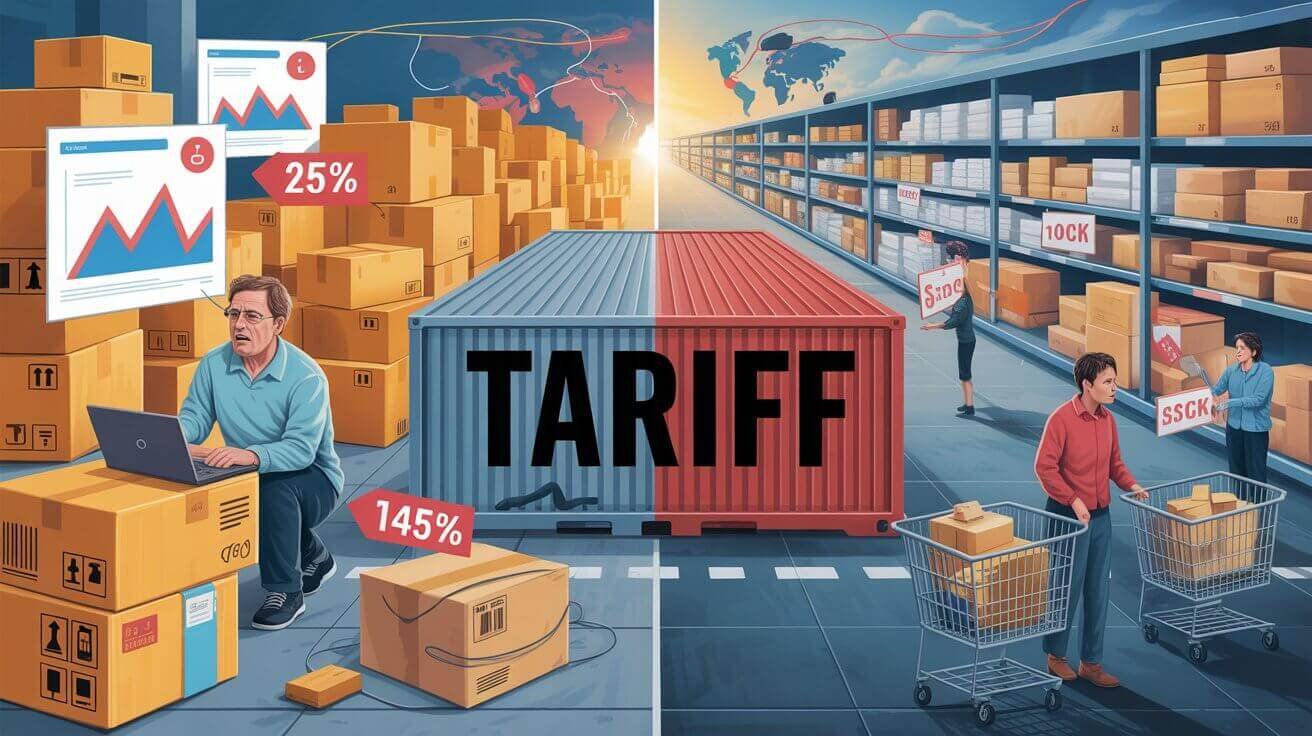Amazon seller Dusty Kenney stands in her California warehouse, surrounded by hundreds of boxes shipped from China before the tariffs hit. Now she’s facing a brutal choice: absorb crushing costs or raise prices and lose customers.
Trump e-commerce tariffs have created the biggest disruption in online retail since the pandemic. Moreover, Trump e-commerce tariffs are forcing retailers to completely rethink their business models as costs skyrocket and profit margins evaporate. The suspension of the $800 de minimis threshold alone affects over 4 million packages daily, fundamentally changing how e-commerce operates.
Understanding Trump E-Commerce Tariffs: The 2025 Policy Changes
President Trump’s latest trade policies represent the most aggressive tariff strategy in decades. Furthermore, these aren’t just minor adjustments—they’re comprehensive changes that affect virtually every online retailer.
E-Commerce Trade Policy: The De Minimis Rule Elimination
The biggest shock came when Trump suspended duty-free de minimis treatment for low-value shipments worth $800 or less from anywhere in the world. Previously, these small packages could enter the U.S. without tariffs or complex customs procedures.
This change specifically targets Chinese e-commerce giants like Shein, Temu, and AliExpress. However, it’s hitting American retailers just as hard.
Trump Tariffs Impact: Blanket and Reciprocal Duties
Additionally, Trump implemented a 10% blanket tariff on all imports, effective April 2025. Countries with “unfair trade practices” face even higher reciprocal tariffs:
- China: Up to 145% on certain goods
- Canada and Mexico: 25% (currently paused for 90 days)
- Various Asian countries: 10-50% depending on trade relationships
Using Emergency Powers
Most significantly, Trump invoked the International Emergency Economic Powers Act (IEEPA) for the first time in history to implement comprehensive tariff regulations. This unprecedented move bypassed traditional trade policy processes.
How Trump E-Commerce Tariffs Are Devastating Online Retail Giants
The numbers tell a stark story about how Trump e-commerce tariffs are reshaping the industry.
E-Commerce Tariffs Hit Amazon the Hardest
Morgan Stanley analysts report that Amazon has the highest exposure to China tariffs among major e-commerce companies. Approximately 25% of Amazon’s first-party cost of goods sold comes from China.
Amazon sellers are getting crushed. Over 70% of products sold on Amazon are manufactured in China, meaning most sellers face immediate cost increases.
Trump Trade Policy Causes Industry-Wide E-Commerce Slowdown
AlixPartners’ latest survey reveals the most significant e-commerce slowdown in over a decade. Nearly all major product categories experienced double-digit declines in online purchases, with only grocery sales remaining resilient.
Key findings include:
- Office supplies down 13% year-over-year
- Electronics seeing price increases of 12.2% to 31.2%
- 81% of e-commerce decision-makers say shifting tariffs put their global strategy at risk
Third-Party Seller Crisis
Small Amazon sellers face an impossible situation. They can’t easily switch suppliers, absorb massive cost increases, or compete with sellers who haven’t been hit by tariffs yet.
“I will hold my prices for as long as I can and just absorb those tariffs,” Dusty Kenney told CNBC. “But if they continue, it could put me out of business.”
Trump E-Commerce Tariffs: Real-World Impact Examples
Understanding Trump e-commerce tariffs requires looking at specific cases where retailers are adapting—or failing to adapt.
E-Commerce Tariffs Case Study: Electronics Seller’s Nightmare
Consider this example from AMZ Prep’s analysis:
Before Tariffs:
- Unit price from China: $10.00
- Shipping: $2.00
- Total landed cost: $12.00
- Selling price: $17.00 (profit margin: $5.00)
After 145% Tariffs:
- Unit price from China: $10.00
- Shipping: $2.00
- Import tariff (145%): $14.50
- Total landed cost: $26.50
- Required selling price: $32.00+ (to maintain $5 profit)
The seller must nearly double their price to maintain the same profit margin. Most customers won’t pay 88% more for the same product.
Handbag Seller’s Dilemma
The Washington Post profiled a seller whose handbags were at sea when Trump announced tariff increases from 104% to 125% to 145% in three days.
“I can’t believe he did that,” she said. “You have to give people enough warning to strategically plan for this.”
Success Stories: Diversification Winners
However, some retailers are finding opportunities. Companies that diversified their supply chains before the tariffs took effect are gaining market share as competitors struggle with higher costs.
Businesses using platforms like Easyship report success by quickly pivoting to suppliers in Vietnam, India, and Mexico (before those tariffs hit).
Surviving Trump E-Commerce Tariffs: Strategic Business Solutions
Despite the challenges, successful retailers are implementing specific strategies to maintain profitability.
1. Immediate Cost Analysis
First, calculate your exact exposure. Webgility recommends running detailed models considering:
- Current product costs
- Supply chain expenses
- Shipping costs under various tariff scenarios
- Your break-even points for each product
2. Strategic Pricing Adjustments
Don’t just pass through tariff costs dollar-for-dollar. Instead:
- Bundle products to maintain perceived value
- Emphasize quality differences over price
- Adjust gradually rather than shocking customers with sudden increases
- Test price elasticity on different product categories
3. Supply Chain Diversification
Although switching suppliers isn’t easy, start exploring options:
- Vietnam and India currently face lower tariffs
- Domestic suppliers offer long-term stability
- Mexico provides proximity advantages (despite current tariff uncertainty)
- Regional fulfillment can reduce shipping costs
4. Inventory Management Revolution
AMZ Prep suggests optimizing inventory levels to minimize storage costs while avoiding stockouts:
- Pre-order high-demand items before further tariff increases
- Reduce slow-moving inventory that ties up capital
- Bundle orders to reduce per-unit customs processing costs
5. Marketplace Diversification
Don’t rely solely on Amazon. Expand to multiple channels:
- eBay, Walmart, Etsy may have different fee structures
- Direct-to-consumer sites offer higher margins
- International markets provide growth opportunities
- B2B sales often have different price sensitivities
Future of Trump E-Commerce Tariffs: What Online Retailers Should Expect
Trump e-commerce tariffs will likely intensify before they improve, creating both challenges and opportunities.
E-Commerce Trade Policy: Escalating Trade War
The 90-day tariff pause expires July 9, with countries facing higher rates if they don’t finalize bilateral trade deals. Some tariffs could reach 50%.
China has already imposed retaliatory tariffs on American food imports, suggesting this trade war will escalate rather than resolve quickly.
Consumer Behavior Shifts
Research shows significant changes in buying patterns:
- 66% of consumers will seek domestic alternatives if import prices rise 10%
- 34% will delay purchases due to price uncertainty
- 28% accelerated purchases to avoid future cost increases
- Only 20% expressed interest in “buying American”
Technology and Automation Advantages
Retailers investing in automation and AI-powered pricing tools are outperforming those using manual processes. Companies using platforms like TrumpTradeTracker.com stay ahead of policy changes and adjust strategies faster.
Consolidation Accelerates
Smaller retailers without resources to adapt will likely exit the market. Meanwhile, larger companies with diversified supply chains and strong balance sheets will gain market share.
“The new tariff landscape, while challenging, presents opportunities for businesses to strengthen their market position,” notes AMZ Prep.
The Bottom Line for E-Commerce Retailers
Trump e-commerce tariffs represent the most significant trade disruption in decades. However, retailers who adapt quickly and strategically can not only survive but thrive.
The key is accepting that the old playbook—relying on cheap Chinese imports and razor-thin margins—no longer works. Instead, successful retailers are building more resilient business models with diversified supply chains, higher-value products, and stronger customer relationships.
This isn’t just about surviving tariffs. It’s about building businesses that can handle whatever trade policies come next. Because if history teaches us anything, it’s that trade policies will keep changing—and the retailers who prepare for uncertainty will always outperform those who don’t.
The disruption is real, but so are the opportunities. The question isn’t whether Trump e-commerce tariffs will continue reshaping the industry—it’s whether your business will be among the winners or casualties of this transformation.
Start adapting now. Your future profitability depends on the decisions you make today.








